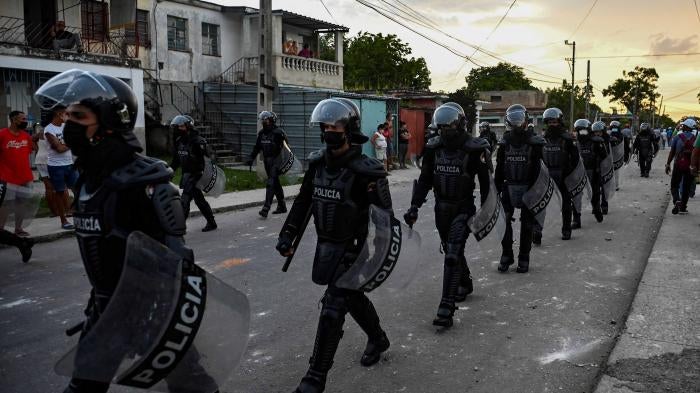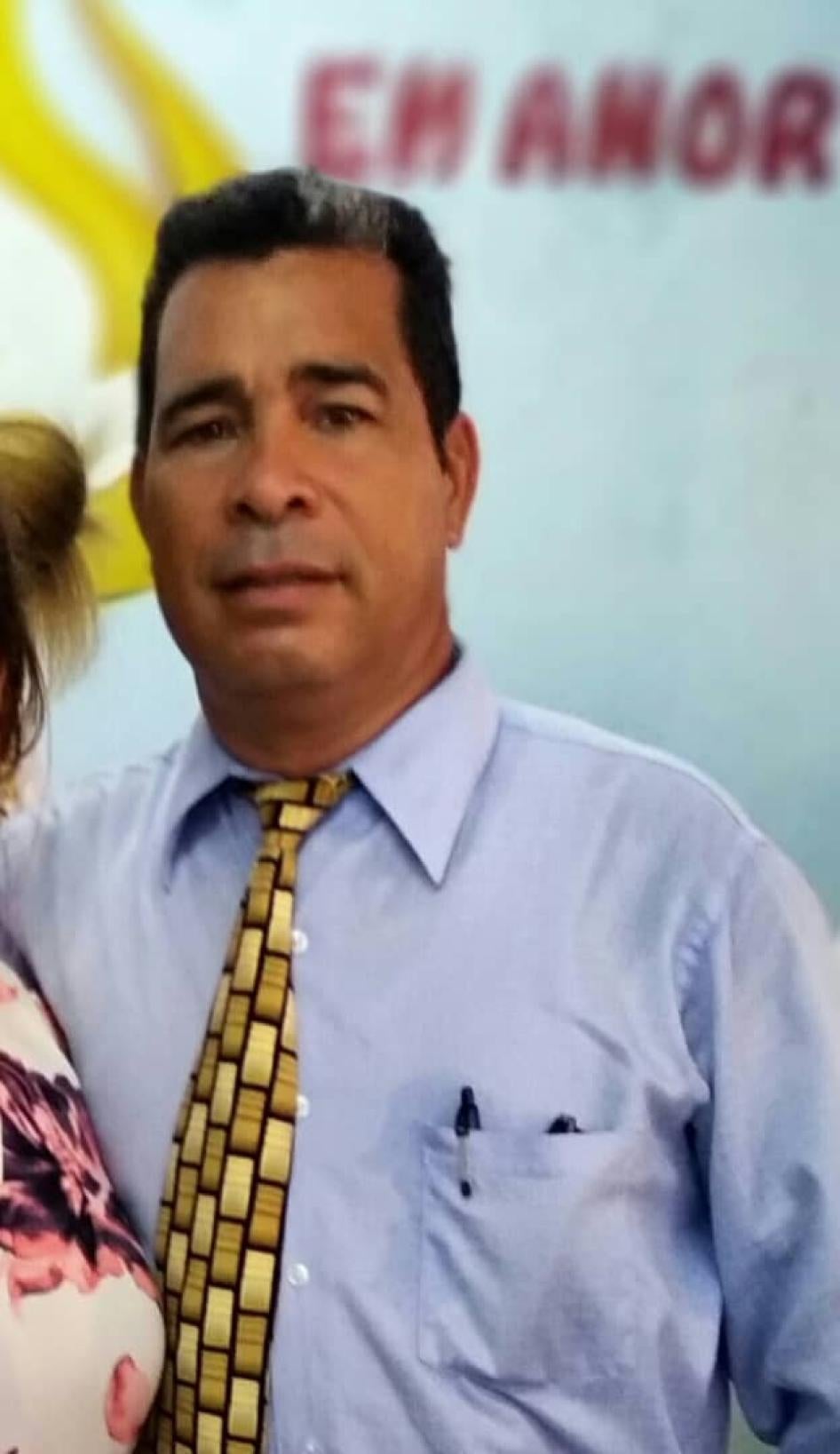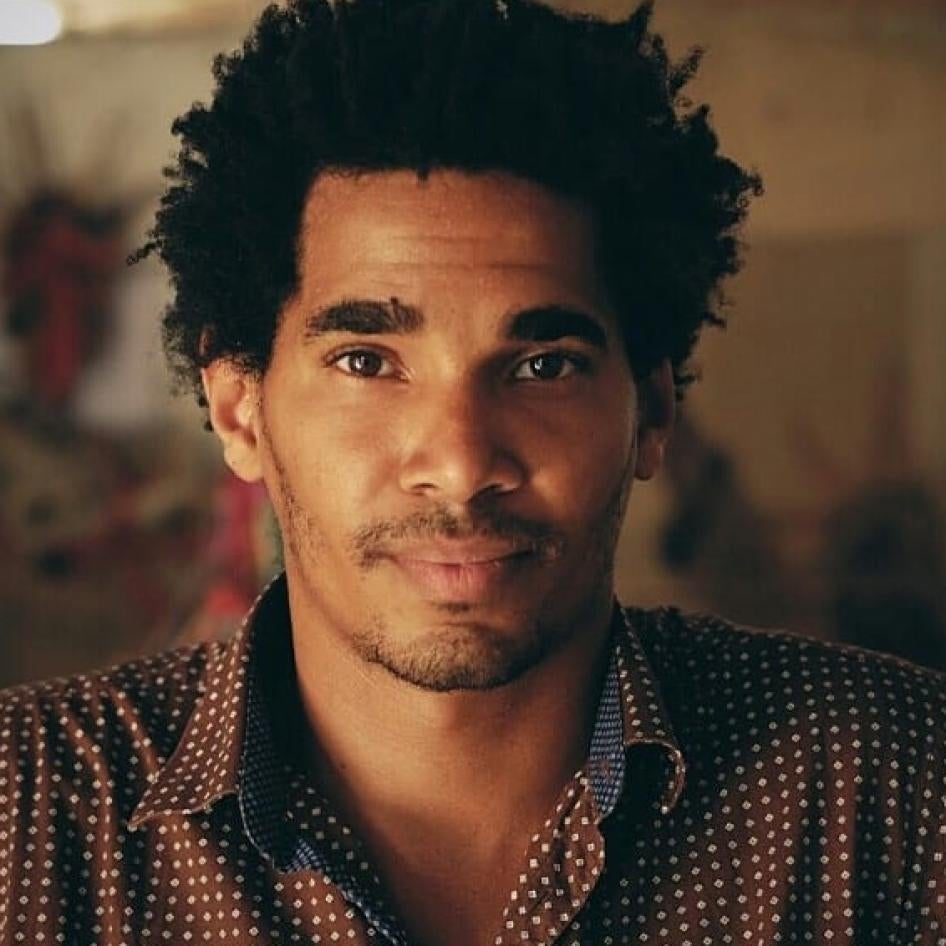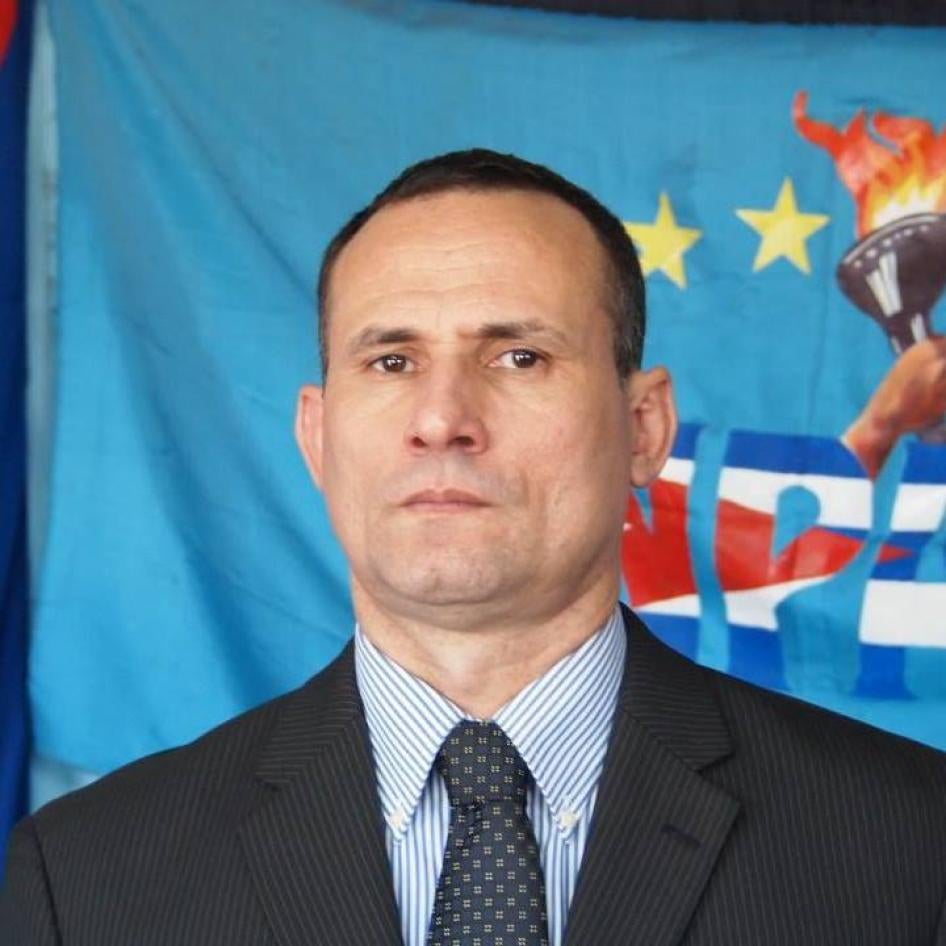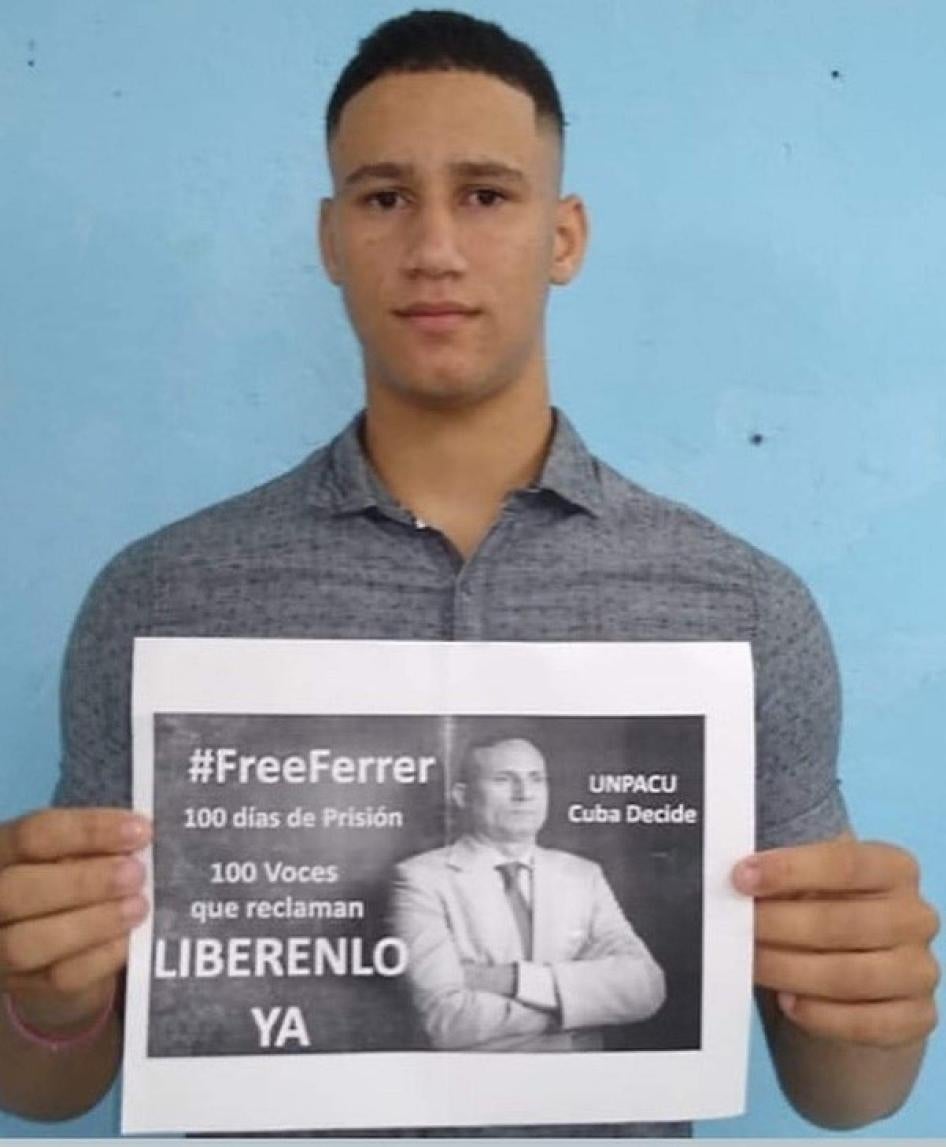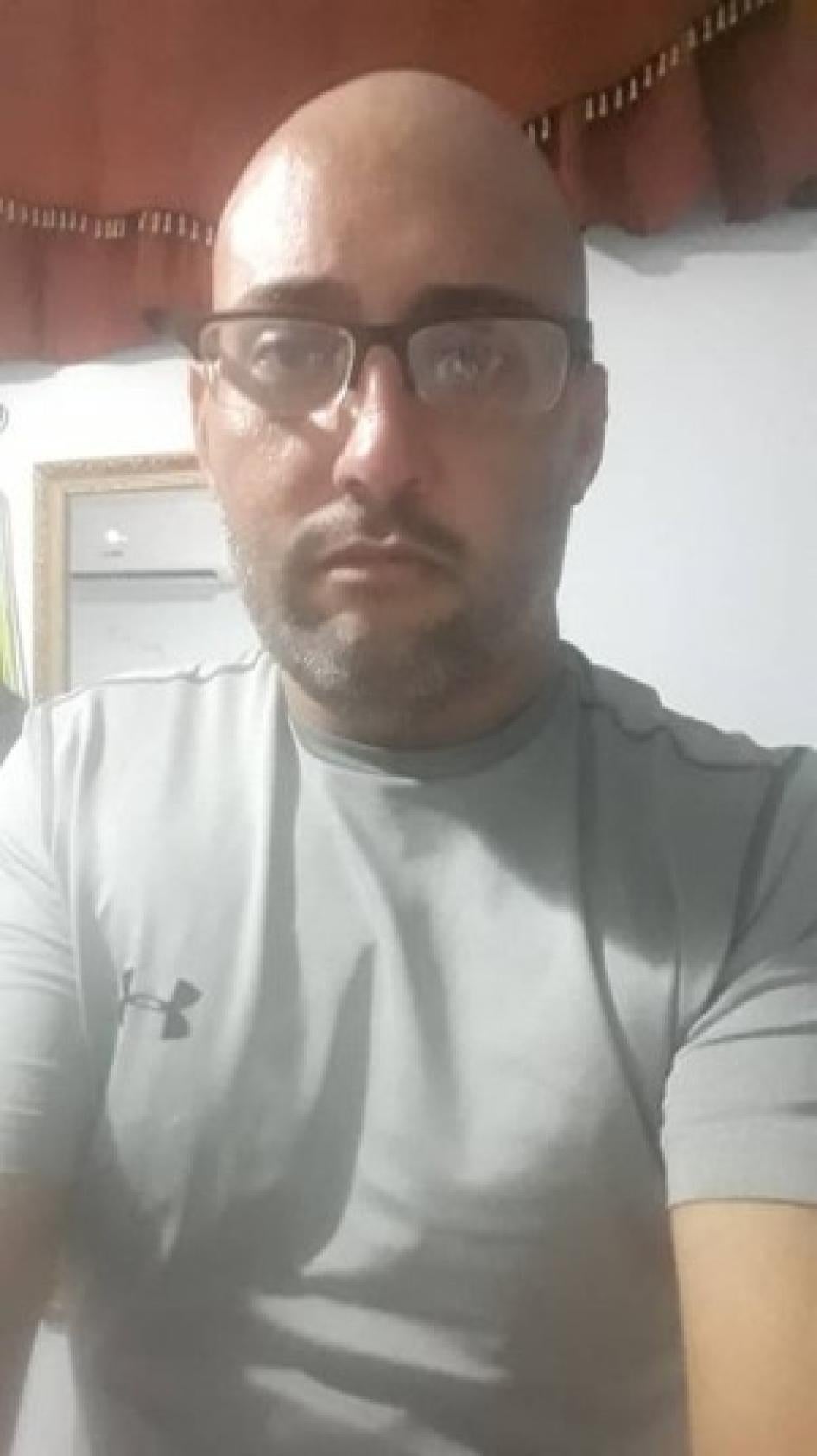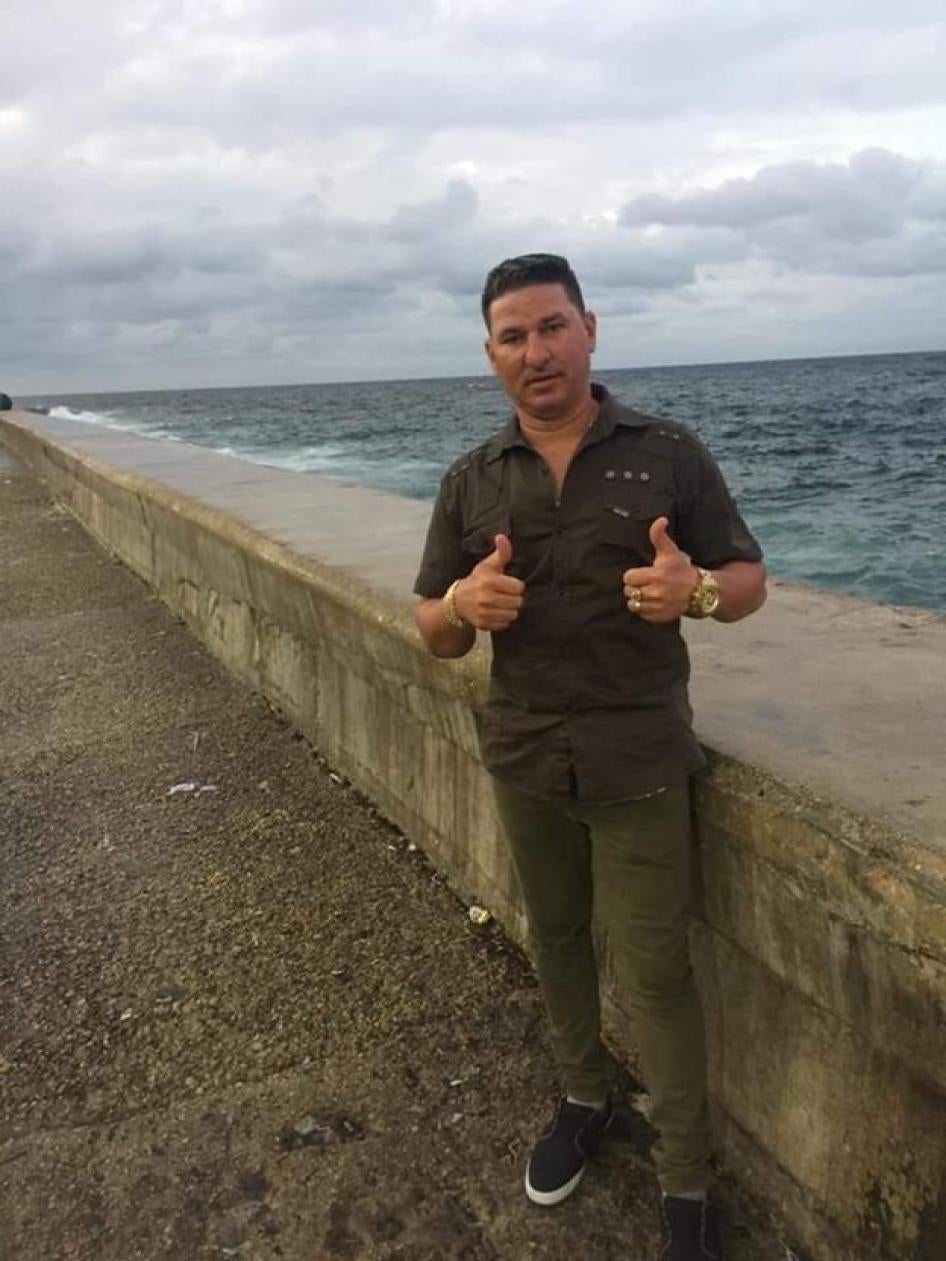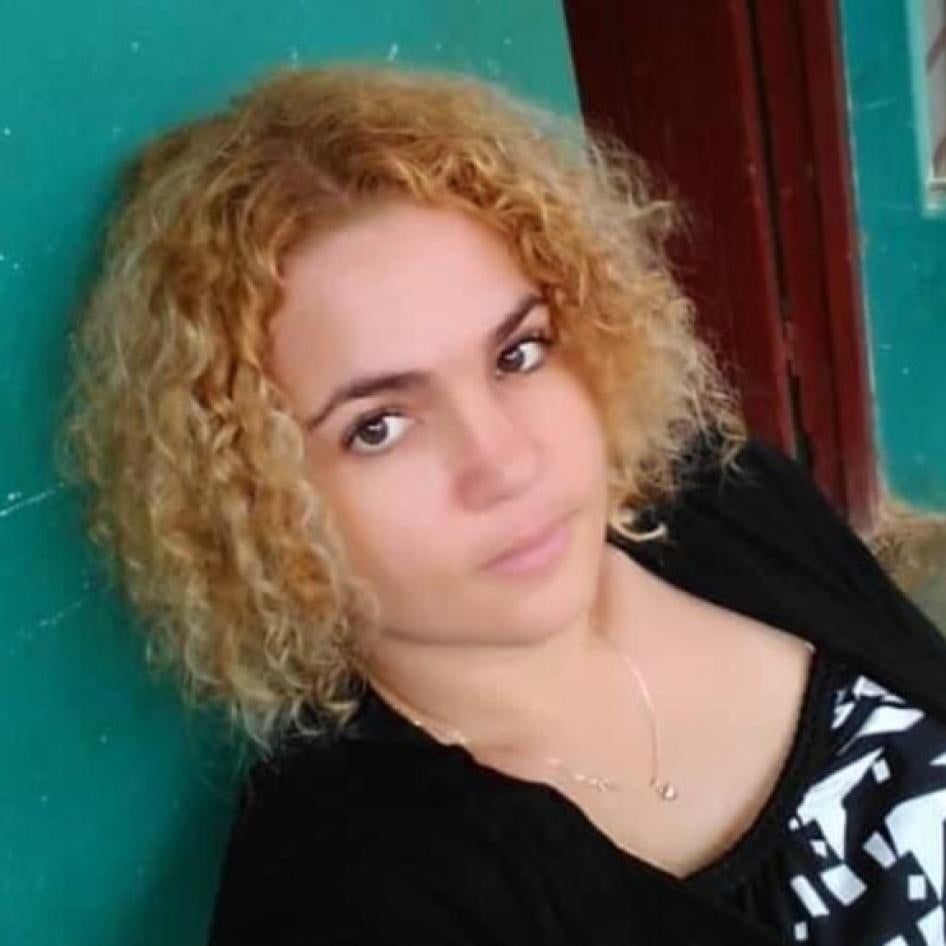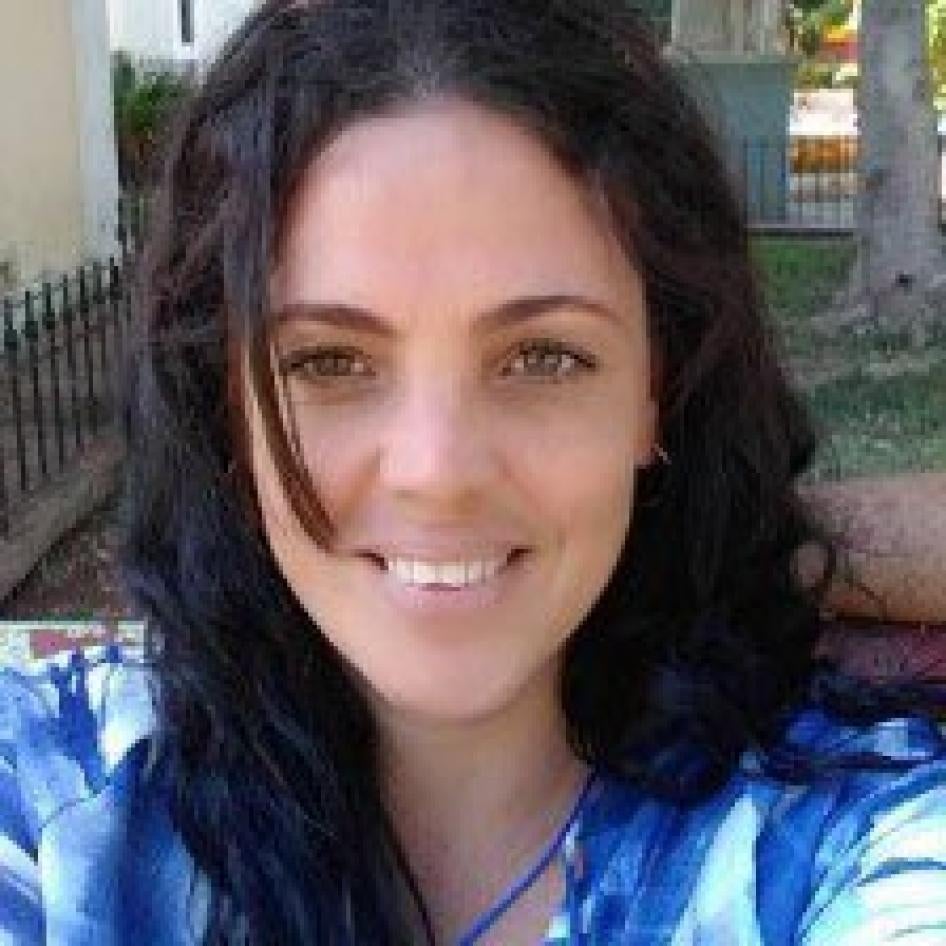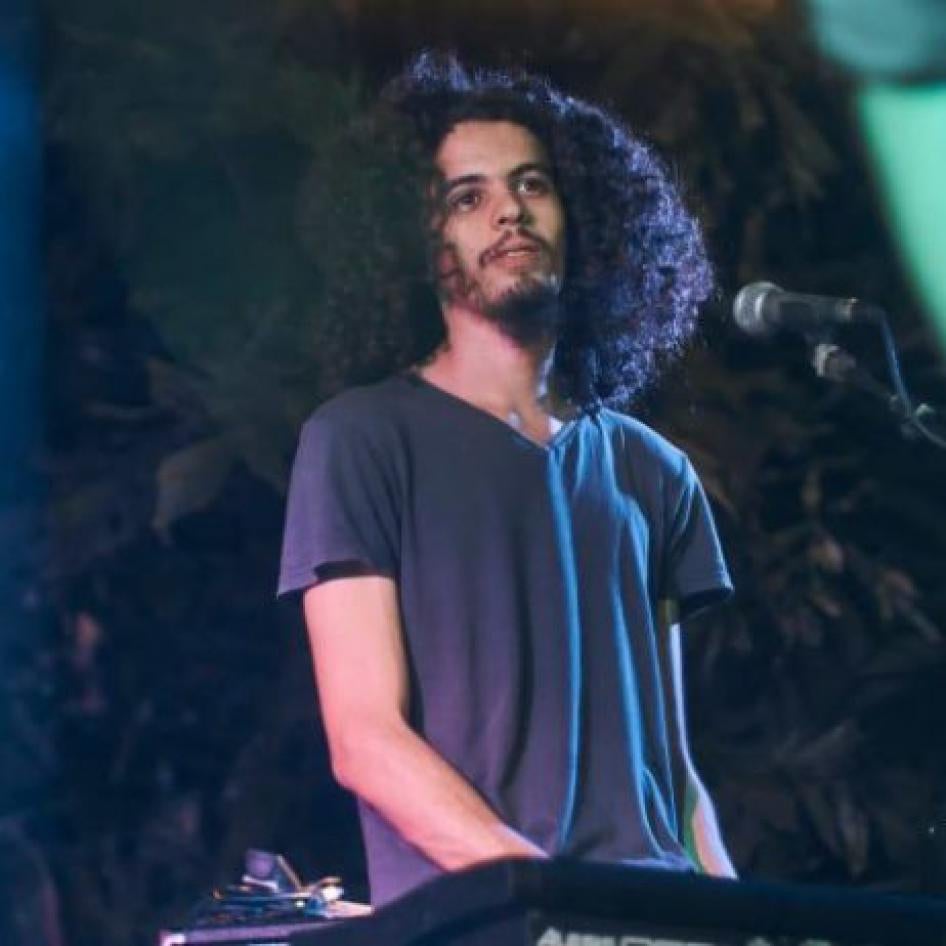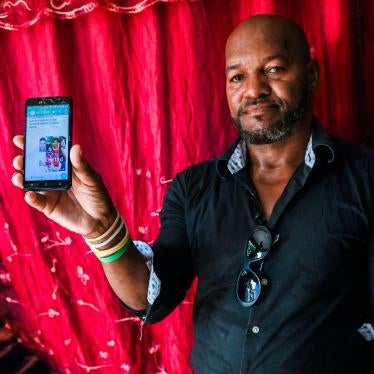Introduction
On July 11, 2021, thousands of Cubans took to the streets in the largest nationwide demonstrations against the government since the 1959 Cuban revolution. These peaceful protests were a response to longstanding restrictions on rights, food and medicine scarcity, and the government’s response to the Covid-19 pandemic. Many protesters chanted “liberty!” or “motherland and life,” referencing a Cuban song that repurposes the government’s old slogan, “motherland or death” (patria o muerte), and criticizes repression in the country.
The government replied to Cubans’ exercise of their rights to expression and assembly with brutal, systematic repression and censorship.
Shortly after the protests began, President Miguel Díaz-Canel urged government supporters and security forces to respond to the protests with force. “We call on all revolutionaries to go to the streets to defend the revolution,” he said. “The order to fight has been given.”[1]
One protester, Diubis Laurencio Tejeda, a 36-year-old singer, died, seemingly at the hands of the police.[2] Cuban rights groups report that over 1,400 people were detained, more than 700 of whom remained behind bars as of July 2022.[3] Cuban courts have confirmed the convictions against more than 380 protesters and bystanders, including several children.[4] Several organizations reported countrywide internet outages on July 11, followed by erratic connectivity, including restrictions on social media and messaging platforms.[5]
This report documents a wide range of human rights violations against well-known government critics and ordinary citizens, including harassment, arbitrary detention, abuse-ridden prosecutions, beatings, and other cases of ill-treatment that in some cases constitute torture.
Human Rights Watch found that rights violations committed in the context of the protests followed patterns that strongly suggest the existence of a plan to prevent people from protesting, punish those who did, and instill fear to prevent massive anti-government demonstrations from taking place again. We found a pattern of abuse in over 155 cases documented during our year-long reporting on the repression against July 2021 protesters in Cuba, including the 14 cases described in detail in this report.[6]
Since July 2021, Human Rights Watch interviewed more than 170 people in Cuba to assess what happened to protestors and government critics on July 11, 2021 and since. Interviewees included victims of abuse, their relatives and lawyers, human rights defenders, and journalists. Whenever possible, Human Rights Watch also reviewed case files, sentences passed on protesters, press reports, and publications by Cuban rights groups. We also verified photographs and videos sent directly to researchers and found on social media platforms. Members of the Independent Forensic Expert Group (IFEG) of the International Rehabilitation Council for Torture Victims (IRCT), an international group of prominent forensic experts, provided expert opinion on some evidence of abuses.
Witnesses identified officials involved in the abuses as being members of the intelligence services, known in Cuba as “state security;” the military; the National Police; and the special national brigade of the Interior Ministry, known as “black berets.” Government-organized groups of civilians known as “rapid response brigades” also carried out several beatings. Prosecutors and judges, who lack independence from the government, enabled and took part in abusive criminal proceedings.
We found that officers repeatedly detained people who were protesting peacefully, arrested critics as they headed to demonstrations, or prohibited them from leaving their homes for days or even weeks.
In most cases documented by Human Rights Watch, detainees were held incommunicado for days, weeks, and sometimes months, without being able to make a phone call or receive visits from their relatives or lawyers.
Most detainees said they were held in crowded and unsanitary prison cells, with little to no access to food, medicines, clean water, or protective equipment to prevent the spread of Covid-19. Many said they were subject to abusive and repeat interrogations in which they were often questioned about issues unrelated to their alleged crimes, such as their family or work. They said they were at times threatened with criminal prosecution if they refused to answer questions about the organization of protests. Some were beaten, forced to squat naked, or subjected to ill-treatment, including sleep deprivation and other abuses that in some cases amount to torture.
Dozens of detainees have been prosecuted in “summary trials” pursuant to Cuban law. Our research shows that protesters were tried jointly, often without legal representation, in largely closed hearings, on vaguely defined charges, such as “public disorder” or “contempt,” with evidence consisting largely of security officers’ statements.
Dozens of others were prosecuted through “ordinary trials” and sentenced to long prison sentences. Many trials took place before military courts, which contravenes international law. Many were prosecuted for “sedition” and sentenced to disproportionate prison terms of up to 25 years for allegedly participating in violent incidents, such as throwing rocks during the protests.
The prosecutions framed actions such as protesting peacefully, insulting the president or the police, or chanting “motherland and life,” legitimate and lawful exercises of freedom of expression and association, as criminal behavior. The prosecution presented, and courts convicted, individuals on unreliable or uncorroborated evidence, such as statements solely from security officers, or alleged “odor traces” of the defendants.
Relatives of detainees, protesters, and activists said that Cuban police officers and state security agents repeatedly harassed them, and in some cases the intimidation forced them to leave the country.
As Cuban authorities take drastic measures to punish people who participated in the demonstrations, they have also taken steps to dismantle the limited space for civil society that allowed these protests to occur in the first place.
In August 2021, the government published Decree Law 35 and several accompanying norms, which severely restrict freedom of expression online.[7] In May 2022, the National Assembly passed a criminal code that, among many other broadly defined norms, includes a provision that would punish with up to 10 years in prison whoever provides, receives, or has funds “with the purpose of paying for activities against the State and its constitutional order.” Such broad language opens the door for sanctions that seriously undermine Cubans’ right to mobilize and peacefully question government abuse.
The government’s repression, as well as its apparent unwillingness to address the underlying causes that took many Cubans to the streets, have forced thousands to leave the country, often through Nicaragua, which waived visa requirements for Cubans in late-2021. The US Border Patrol apprehended over 118,000 Cubans between January and May 2022—a dramatic increase from the over 17,000 in same period in 2021.[8] The US Coast Guard has interdicted over 2,900 Cubans on the sea since October 2021, by far the highest figure in five years.[9]
Many Cubans have fled to countries other than the United States, including in Latin America and Europe. Human Rights Watch research in the Darien Gap, a jungle on the border between Colombia and Panama, and in Mexico’s southern border shows that Cubans undertaking the dangerous journey north through Latin America face abuse by gangs and difficulty accessing legal status in the region.[10]
The international community has for decades been unable to secure sustained progress on human rights in Cuba. In particular, multilateral pressure—including from Latin American countries, the United States, Canada, and Europe—has been lacking for years.
Efforts by the US government to press for change by imposing a sweeping economic embargo have proven costly and misguided. Rather than isolating Cuba, the decades-long policy has isolated the United States by enabling the Cuban government to garner sympathy abroad while simultaneously alienating Washington’s potential allies.
Meanwhile, many Latin American governments, including Mexico and Argentina, have been reluctant to criticize Cuba and, in some cases, have even openly praised the Cuban government, despite its dismal human rights record.
The actions taken by the Cuban government violate a range of human rights protected under several treaties, including the International Covenant on Civil and Political Rights (ICCPR) and the Convention against Torture (CAT). These include the rights to freedom of expression and association, security and liberty, due process guarantees, as well as to be free from torture and other cruel, inhuman, or degrading treatment. Cuba is a party to the CAT and signed the ICCPR in 2008, but it is among the few states that has yet to ratify it.[11] These rights, set out in the Universal Declaration of Human Rights, are also part of customary international law.
The United States, Canada, the European Union, and governments in Latin America should ensure a multilateral and coordinated approach towards Cuba that expresses support for the rights of Cuban protesters, journalists, and activists, and condemns repression in the country.
Recommendations
To Latin American Governments, the United States, Canada, the European Union, EU Member States, and Other Concerned Governments:
- Ensure a multilateral and coordinated approach toward Cuba that prioritizes human rights in the country.
- Unequivocally condemn the repression against demonstrators and critics in Cuba and call on the Cuban government to release all those arbitrarily detained.
- Publicly express support for the rights of Cuban protesters, journalists, and activists.
- Implement commitments laid out in the Los Angeles Declaration, adopted during the Summit of the Americas in June 2022, to strengthen safe, legal pathways for Cubans to migrate and to ensure that asylum seekers can access protection.
- Prioritize monitoring and denouncing restrictions on internet access in Cuba.
To the Biden Administration in the United States:
- Progressively dismantle the policy of isolation toward Cuba, including by replacing the embargo and the existing bans on travel and trade with Cuba with more effective forms of multilateral pressure.
To Members of the United Nations Human Rights Council:
- States should bring attention to the situation in Cuba and raise human rights concerns during Council meetings and debates, including during Interactive Dialogues with relevant Special Procedures mandate-holders or in their statements under item 4.
To the UN High Commissioner for Human Rights:
- Closely monitor the human rights situation in Cuba and publicly condemn human rights violations in the country, including systematic abuses against demonstrators and critics.
To Relevant UN Special Procedures:
- Monitor and report to the Human Rights Council and, when appropriate, to the Third Committee of the United Nations General Assembly, on human rights violations within their mandates, including on freedom of peaceful assembly and association, freedom of opinion and expression, the situation of human rights defenders, and on torture and other cruel, inhuman, or degrading treatment, particularly regarding Cuban authorities’ abusive practices against demonstrators and critics.
To States Party to the 1984 Convention against Torture and the Inter-American Convention to Prevent and Punish Torture:
- Exercise universal jurisdiction, to the extent permitted under domestic law, over any Cuban officials responsible for torture, in accordance with article 5 of the Convention Against Torture.
Selected Cases
Lorenzo Rosales Fajardo, 50, and his son, 17, in Palma Soriano
After leading a church service at home in Palma Soriano, a city in southeastern Cuba, on July 11, Lorenzo Rosales Fajardo, a 50-year-old evangelical pastor, joined the protests with his son, then 17. A family member said they protested peacefully and refrained from offensive remarks about the government, which would have been against their faith.[12]
Anti-riot police detained Rosales Fajardo, the family member said, dragging him, beating him with batons on his back and face, and knocking out a tooth and several fillings. When his son asked agents for his whereabouts, they detained him as well.
They were taken to different police stations. In the early morning, both were transferred to an abandoned school in Santiago de Cuba. Rosales Fajardo was held there for two days; his son, for a week.
Until his release on July 18, the son was held in an overcrowded, improvised cell on the school’s second floor. During his detention he was given rotten food and little to no water. Officers repeatedly woke him and other detainees during the night, beat them and pushed them down the stairs, with their hands tied. They were stripped of their clothes and forced to squat naked in front of others on several occasions, the relative, who spoke with him after the release, said. Officers told the son that he was under investigation for “public disorder.”
Rosales Fajardo was transferred on July 14 to the provincial security headquarters in Versalles, a suburb of Santiago de Cuba city. On the way, police beat him and he lost consciousness; when he awoke, agents were urinating on him, the family member said.
His family only learned of his whereabouts when a pastor informed them, six days after the arrest.
At Versalles, Rosales Fajardo was held alone in a small, dark cell. He was interrogated at all hours. Officers asked who was paying him, who his boss was, who had sent him to the protest. The cell sometimes filled up with insects, which he could not see in the dark and bit him all over. He could never tell whether it was day or night, the family member said.
With other detainees, Rosales Fajardo was transferred to a maximum security prison in Boniato, on the outskirts of Santiago de Cuba, on August 6. Prisoners insulted and beat them when they arrived. They forced some to perform oral sex on prisoners, the family member said.
Rosales Fajardo’s family was first able to speak with him by phone the day after the transfer and was able to visit him on October 16. He “cannot stop crying,” the family member said, when he speaks of the treatment he and others have endured.
After a closed-door trial with 15 other defendants in a Palma Soriano municipal court, on December 20 and 21, 2021, Rosales Fajardo was convicted of “public disorder,” “contempt,” and “assault.” The prosecutor accused him of calling on other neighbors to join the demonstrations, insulting President Díaz-Canel and police officers, and pushing officers to break a police cordon.[13]
His attorney was not allowed to present video evidence, and the court allowed the defense to call only two witnesses, who said Rosales Fajardo had protested peacefully and had not made offensive comments. The judge ruled that all the security agents who testified in the trial were “reliable, clear and impartial,” while civilian witnesses who testified in favor of the defendants had provided “contradictory” evidence and were not credible.[14]
Rosales Fajardo was sentenced to seven years in prison on April 29, which was confirmed by an appeals court on June 24. Rosales Fajardo remained in Boniato prison at time of writing.
Miguel Díaz Sosa, 48, in San Antonio de los Baños
After nearly three weeks of a pandemic-related lockdown that prevented him from fishing, Miguel Díaz Sosa, a 48-year-old fisherman, joined a July 11 protest in the park in front of his house in San Antonio de los Baños, a municipality in Artemisa province.[15]
The day after the protest, approximately 20 agents from various police units arrested him at home, a family member said.
Authorities held Díaz Sosa incommunicado for 12 days at the local jail and about the same amount of time at the state security’s detention center in nearby Guanajay, where his relatives were allowed 10-minute visits once a week but phone calls remained prohibited, the family member said. He was then transferred to Guanajay prison.
In November, he spent nearly 10 days in a cold, damp “punishment cell,” accused of having spoken of a protest planned for November 15. Díaz Sosa, who suffers from hypertension and has a plate in his skull from an earlier injury, developed asthma, headaches, and eventually hallucinations, the family member said.
Months after the arrest, authorities told the family that Díaz Sosa was being accussed of “public disorder,” for attending the demonstration; “assault,” for forcefully breaching the police line with other protesters; and two counts of “contempt” for shouting slogans in opposition to the president and police and telling the secretary of the Communist Party’s municipal committee “we do not want dialogue, no more lies.”[16]
He was one of 17 people tried jointly, between December 13 and 15, in a Guanajay provincial court. He was able to see his lawyer only once before trial, the family member said. One relative of each accused was allowed to attend the heavily policed proceedings. Attendees were threatened with expulsion, the family member said, if they “so much as glanced sideways.”
Defendants and their families were not allowed to see the videos that prosecutors introduced as evidence, said the family member, who was present at the trial. The ruling does not provide information about what these videos purport to show Díaz Sosa doing.[17] Díaz Sosa testified that he had protested peacefully and had not offended nor attacked police. Several witness spoke of his good conduct, but the judges said that they could not be given “complete credit.”[18]
Díaz Sosa was convicted on all counts and sentenced to eight years in prison. His family has appealed. Díaz Sosa remained in Guanajay prison at time of writing.
Luis Manuel Otero Alcántara, 34, in Havana
Luis Manuel Otero Alcántara, an independent artist and one of the performers in “Motherland and Life,” was detained on July 11, around 3 p.m.[19] He called his girlfriend to say that he was participating in a peaceful demonstration in downtown Havana. Hours
later, a witness told his girlfriend that several police officers and state security agents had detained Otero Alcántara.[20]
On July 16, an officer told Otero Alcántara’s lawyer that he was being detained in Villa Marista, a state security facility in Havana, and would be transferred to Guanajay maximum security prison. The officer said he was being investigated for “assault,” “resistance,” and “contempt,” but did not explain on what basis or evidence.[21] On August 5, his lawyer was allowed to see him for the first time.[22]
Otero Alcántara had been detained previously for short periods of time and charged several times for criticizing the government, but he had never been held in custody while those charges were being deliberated upon.
In February 2022, Alcántara was charged with “insulting national symbols” for his use of the Cuban flag in the performance piece Drapeau, which consisted of him wearing the Cuban flag and carrying it around with him 24 hours a day for a month in 2019.[23] A prosecutor in Havana requested a 7-year sentence.[24]
He was also charged with “public disorder” and “contempt” for gathering with Maykel Castillo Pérez, a rap singer, and other people during an April 4, 2021 protest, playing “Motherland and Life” in public, chanting an “offensive” song against President Díaz-Canel and saying “offensive words” against other government officials.[25]
Cuban authorities repeatedly offered Otero Alcántara release from jail in exchange for leaving the country indefinitely—an offer that the Cuban government has made to other critics in recent months.[26] Otero Alcántara publicly rejected it.[27]
Otero Alcántara was tried, along with Maykel Castillo Pérez, on May 30 and 31 before a court in Havana. Authorities only allowed two relatives per detainee to be present at the trial.[28] On June 24, Otero Alcántara was convicted and sentenced to five years.[29]
Otero Alcántara remained in Guanajay prison at time of writing.
José Daniel Ferrer García, 51, and José Daniel Ferrer Cantillo, 18, in Santiago de Cuba
José Daniel Ferrer García, president of the opposition group Cuban Patriotic Union (UNPACU), and his son, José Daniel Ferrer Cantillo, were detained on July 11, around 5 p.m.,
as they headed to a demonstration in front of the José Martí theatre in Santiago de Cuba.[30] Ferrer Cantillo told Human Rights Watch that the officers detained them violently, pushing them toward the police car, even when they were not resisting arrest.[31]
The two were taken to the local Center of Operations, Investigations, and Criminal Proceedings (Centro de Operaciones, Investigaciones e Instrucción Penal, UPICO), a detention center, where officers separated them.[32]
Ferrer Cantillo said he and two other detainees were held in a two-by-two-meter cell that had no windows nor artificial light. Officers interrogated him several times, asking him why he had participated in the protests and threatening him with a prison sentence. He began a hunger strike when he arrived in prison. Officers repeatedly took him to the prison’s infirmary, but instead of giving him medical assistance, they tried to convince him to abandon his strike, saying that he would die if he continued.[33]
The day after they were detained, Ferrer García’s wife went to multiple local police stations to ask for them. Instead of informing her about their whereabouts, an officer detained her for five hours in a local police station where, she says, she was made to stand in the sun for five hours. When they released her, an officer told her that Ferrer was in the UPICO and that he would serve “a lot of time in prison.”[34]
A prosecutor’s document, dated July 17, instructed Ferrer García to be held in pretrial detention but Ferrer Cantillo to be released. The document says both father and son are under investigation for “public disorder” because they “decided to join” protests “against the revolutionary process” and shouted, “down with Díaz-Canel!” and “down with hunger!” when they were being detained. The document also says that José Daniel Ferrer García “talks against the revolutionary process” and his son “has relationships with people who talk against the revolutionary process.”[35]
Ferrer Cantillo was released on July 17. An officer gave him a notice informing him that he was under investigation for “public disorder” and told him he could not participate in demonstrations. He refused to sign the notice.[36]
On July 22, their family presented a habeas corpus requesting Ferrer García’s release, which was summarily dismissed the next day.[37] The court decision rejecting the petition indicates Ferrer García is “under investigation” but does not indicate what he is being investigated for, nor where he is being held.[38]
Ferrer García’s wife said she went to the UPICO several times, but officers refused to inform her about her husband’s whereabouts.[39] On July 21, she was again detained for two hours when she asked to see him, she said.[40] On August 12, an officer in UPICO finally confirmed that Ferrer García was there but said he could not receive visits.
On August 14, Ferrer García’s wife received a document from a Santiago de Cuba tribunal indicating that Ferrer had to serve 4 years and 14 days in prison in connection with an April 2020 conviction that imposed “limitations of freedom” on him for allegedly assaulting an individual.[41]
Under Cuban law, people under “limitations of freedom” are required to “have an honest attitude towards work” and “strictly respect the laws”—two conditions the Santiago de Cuba tribunal said Ferrer García had now violated.[42] In October 2020, the United Nations Working Group on Arbitrary Detention concluded that Ferrer García had been arbitrarily detained, denied a fair trial, and been a victim of an “enforced disappearance” following his detention.[43]
His family was allowed to see him in prison only 90 days after his arrest. A family member said he is very ill, has severe head and ear pain, hypertension, a stomach ulcer, and has partially lost his sight. His family sent him medicines but said they did not know if the authorities had handed them to him.[44]
Ferrer García told his family that his cell had no windows nor natural air and that he was not allowed access to the open air. His cell had lights on 24-hours a day.[45]
Ferrer García remained in Mar Verde prison on the outskirts of Santiago de Cuba at the time of writing.[46]
Orelvys Cabrera Sotolongo, 36, in Cárdenas
Orelvys Cabrera Sotolongo, a journalist for the news website Cubanet, participated in the July 11 protests in Cárdenas, Matanzas province, with his partner, Yunior Pino Pérez. They said the protests were largely peaceful, though in the evening some individuals broke the windows of some stores and vandalized two police cars.[47]
They said they decided to leave the protests and that a police car intercepted them as they walked back home. An officer from the state security, whom Cabrera recognized from a prior detention, asked them for their IDs, which they did not have. Cabrera said the officer told him he was being taken to a police station because he had been seen in the protests.[48] They let his partner go.
In the police car, an officer told Cabrera that they had a video of him vandalizing stores, which Cabrera denies. They took him to a local police station, where an officer accused him of “promoting” and “financing” protests in Cárdenas. Officers interrogated him, then placed him in a police car parked by the station, where he was held handcuffed for several hours that night.[49]
Around midnight, Cabrera said they took him to a facility in Matanzas, known as “El Técnico,” belonging to the state security’s investigation department. Officers took him to a room and told him that they wanted to “make him aware” that the “revolution had given him everything” and he should not “betray it.”[50]
Cabrera said he was held with eight other detainees in a two-by-one-and-a-half-meter overcrowded cell, with little to no ventilation, light, or access to water. The cell only had a small window allowing detainees to see outside and four concrete beds. One of his cellmates had Covid-19 symptoms, Cabrera said.[51]
Officers interrogated him repeatedly during his detention, often telling him that he would not see his family again and could face between 10 to 15 years in prison. On one occasion, an officer accused him of paying people to participate in the protests. Another time, he said, they showed photos of him taking photos of the protests, saying that these amounted to an “instigation to commit crimes.”[52]
Cabrera was only allowed to make a phone call on July 21—10 days after his arrest. He called his partner to inform him where he was being held. Until then, his family did not know his whereabouts.[53]
On August 13, officers transferred him to the Combinado del Sur prison in Matanzas, telling him that he had been placed in pretrial detention. In the prison, officers shaved his hair and beard and tested him for Covid-19. His test was negative. He was held with nine other inmates, but the cell was larger and had better ventilation, Cabrera said.[54]
On August 19, officers released him. They said he would be placed under house arrest, pending a trial for “public disorder.” An officer told him that he should leave the country.[55]
On September 2, police officers summoned him to a station in Cárdenas, where they fined him 1,000 Cuban pesos (approximately US$40). They told him he had been acquitted for the crime of “public disorder,” but remained under investigation for “spreading of an epidemic.”[56]
On November 12, state security agents summoned him to their offices in Matanzas, where they said they had initiated an investigation against him for a range of crimes, including for working as a journalist without “permission.” They said he could receive a sentence of 30 years in prison, he said. A few days later, a man approached him saying he was a state security agent and told him he should leave Cuba.[57]
On December 19, Cabrera Sotolongo and his partner took a plane to Moscow, Russia, one of the few countries where Cubans do not need a visa. In March, a nongovernmental organization helped them obtain a visa to enter the European Union. They went to the Czech Republic and shortly after took a plane to Mexico. They had requested asylum in the United States at time of writing.[58]
Osain Denis Trujillo, 41, in Cárdenas
Osain Denis Trujillo, a human rights activist, and his family participated in the July 11 demonstrations in Cárdenas, Matanzas province, to protest limited access to medicine in Cuba, which, they say, had caused a relative to die in hospital a day earlier.[59]
On July 12, a relative said, a police car and several “black beret” officers appeared at their home and arrested Trujillo. They did not show a warrant nor say why he was being detained. Although Trujillo did not resist, an officer punched him the face repeatedly and then twisted his arm to immobilize him.
The officers took him to a police station in Cárdenas and, hours later, transferred him to a facility of the Technical Department of Investigations (Departamento Técnico de Investigaciones, DTI), a Ministry of Interior agency charged with investigating crimes.
Trujillo was not allowed to call his relatives or lawyers. He received the first visit, from his lawyer, on September 2. Trujillo told his lawyer that officers had beaten him “until he fainted” when he arrived at the DTI facility.
Trujillo suffers from gastritis. His family sent him medicines, but they do not know if he received them. On August 10, his family learned that he had been taken to a hospital for a check-up because he was “vomiting blood.”[60]
On March 15-17, 2022 Trujillo stood trial with 15 others in a municipal tribunal in Cárdenas. A prosecutor asked that he be sentenced to seven years in prison for “public disorder” and “contempt.”[61] The prosecutor said that Trujillo had tricked officers of the local communist party office into letting him in the building, and then used a microphone to deliver a speech from the office’s balcony complaining about the lack of medicines in hospitals. He also accused Trujillo of shouting “motherland and life” and insulting President Díaz-Canel.
The court sentenced to Trujillo to three years in prison. At time of writing, he remained in detention in Agüica prison in Matanzas, pending an appeal.
María Cristina Garrido Rodríguez, 39, and Angélica Garrido Rodríguez, 41, in Quivicán
María Cristina Garrido Rodríguez, a 39-year-old activist with the Cuban Republican party, and her sister, Angélica Garrido Rodríguez, a 41-year-old housewife, participated in protests on the morning of July 11 in Quivicán, Mayabeque province. The morning protests were peaceful, with demonstrators chanting “motherland and life,” and were not repressed, witnesses said.[62]
The next day, when María Cristina and Angélica were going to the local police station to see some friends who had been detained during the demonstrations the previous night, two police officers and two state security agents intercepted them on the street and arrested them.
The officers took them to the local police station and transferred them later to “El Técnico,” a state security facility.
Angélica was not allowed to receive visits until July 26, when her husband was allowed to see her. An officer was in the room, so she could not say much about her detention, her husband said. Angélica mentioned she had not been beaten but said she had suffered psychological abuses. She also said that for some time she had shared a cell with a man.
María Cristina was not allowed to make a phone call or receive visits until July 31, when her husband was allowed to see her for 15 minutes. María Cristina told him that a female
officer had beaten her with her fists on her legs and arms. She also said that the same officer repeatedly woke her up in the early morning and forced her to shout “long live Fidel!” and “long live the revolution!” One time, María Cristina refused and was sent for 24 hours to what she described as a “punishment cell,” which did not have any light, water, or sanitation facilities.
On January 20 and 21, María Cristina and Angélica were put on trial along with five other people in San José de las Lajas. Only one relative per defendant was allowed to be present.
María Cristina was accused of “resistance,” “assault,” “instigation to commit crimes,” and “public disorder.” Angélica was accused of “public disorder” because of her participation in the protests; and of “contempt,” “assault,” and “resistance” because she allegedly resisted the arrest, her relatives said.
Five police officers testified against them, and the defense lawyer was not allowed to present evidence, their relatives said.
The court convicted them of “assault” and acquitted them of the remaining charges. María Cristina was sentenced to seven years in prison and Angélica to three.[63] A higher court confirmed the sentence on May 30, their relatives said, though they have not been able to obtain a copy of the decision.
The two women remained imprisoned in the women’s prison in La Lisa, Havana province, at time of writing.
Abel González Lescay, 22, in Bejucal
Abel González Lescay, a 22-year-old music student, participated in protests in the town of Bejucal, Mayabeque province, on July 11, 2021.[64]
The next day, at 6 a.m., more than 20 police and intelligence officers appeared at his house, asking for him, a relative who witnessed the detention said. When another relative asked to see a warrant, the agents stormed into the house, saying they did not have one. They handcuffed González in his bedroom, and put him, naked, into a police car.
Hours after a relative went to a police station to report the arbitrary detention, an official of the DTI facility in Bejucal called to ask the relative to bring over clothes for González. Officers there said González was under investigation but did not say why or allow the relative to see him.
On July 18, after holding him incommunicado for six days, officers took him home, saying he was under house arrest pending trial for “public disorder,” a relative said.
On January 22, 2022 he stood trial in Mayabeque with five other defendants. A prosecutor accused him of insulting police officers and President Díaz-Canel during the July 11 demonstration. He asked a judge to sentence González to seven years in prison for the crimes of “public disorder” and “contempt.”
On March 30, a Mayabeque court informed his family that he had been sentenced to six years in prison.[65] His lawyer appealed. At time of writing, González remained under house arrest pending a decision.
Yeremin Salsine Jane, 31, in Artemisa
Yeremin Salsine Jane, a grocery store employee, was arrested on July 11 at a demonstration in the city of Artemisa, southwest of Havana.[66]
The protest was peaceful, a family member present said, until a police truck carrying state security agents without uniforms arrived. The truck lurched back and forth through the crowd, she said, catching a bicycle underneath and threatening to hit the demonstrators surrounding it. Several tried to stop it, and Salsine Jane climbed on the left running board and hit the side of the truck, a video posted to Facebook on September 6, 2021 shows.[67]
After the truck left, an anti-riot squad attacked demonstrators, the family member said. Agents threw Salsine Jane on the ground, bashing his head, and hit him, hurting his wrist and knee. He passed out for several minutes and woke up in a “pool of blood,” the family member said. Agents arrested him and took him to a local police station. That night, he was transferred to a DTI facility in Guanajay and taken the hospital to get stitches.
The family was only able to see him for a few minutes 10 days later, after pleading for proof that he was alive. They said he was stil injured and had a scar on his head, but they were not allowed to take photos. Authorities only allowed Salsine Jane to meet with his lawyer once or twice, citing Covid-19, the family member said.
At a closed-door trial of 13 demonstrators in Artemisa’s provincial court, November 22 to 24, prosecutors accussed Salsine Jane of hitting the truck’s left door and breaking its window to “intimidate” the driver.[68]
Evidence against him consisted of witness statements and a video in which he is seen stepping onto the running board and pounding the left side of the truck.[69] The court dismissed testimony from a witness who said that Salsine Jane’s sole objective had been to stop the truck. According to his family, he was trying to get the driver to stop so others would not get hurt, and he neither hit the driver nor broke the window, which another protester had hurled a rock at.
Salsine Jane received a prison sentence of 10 years for “assault,” stemming from the truck incident; “contempt” for shouting slogans against authorities and saying they were “corrupt;” and “public disorder,” for participating in the protest.[70]
At time of writing, he was being held at Kilo 5 ½ prison in Pinar del Río province, pending appeal before the Supreme Court. The wound to his head, where he received seven stitches, has not healed, and he suffers frequent headaches, the family member said.
Yunier Claro Laguardia, 43, in San Antonio de los Baños
Yunier Claro Laguardia, a 43-year-old bricklayer, participated peacefully in the protests in the town of San Antonio de los Baños, southwest of Havana, on July 11. Police arrested him at home on August 10, a family member said.[71]
Laguardia was held for two months at Taco Taco prison in San Cristóbal, where authorities denied him calls and visits, citing Covid-19. Since then, he has been held at the Guanajay maximum security prison. Guards beat Laguardia and others on November 13, the family member said, for starting a hunger strike. They stripped them down to their underwear, shackled their hands and feet, threw them on the ground, and beat them up.
At a closed-door trial with 16 others in San Antonio de los Baños court, held December 13 to 15, prosecutors requested a 10-year sentence for Laguardia on charges of “public disorder” and “contempt.”[72] They accused him of shouting slogans against the police and the president; calling the secretary of the Communist Party’s municipal committee a “liar” and shouting “we do not want dialogue, no more lies;” and leading the crowd toward the city council and the party’s headquarters.[73]
Security forces have repeatedly harassed relatives of the protesters from San Antonio de los Baños who were tried jointly. On January 14, 2022, six relatives were summoned to the DTI detention center in Guanajay. They were taken to meet the director of Guanajay prison, the San Antonio de los Baños chief of security, and a security guard. The men interrogated them about photos circulating on social media where they were making an “L” sign with their hands (for “Libertad,” freedom in Spanish). They told them they should not have posted the photo, because “that is what the counterrevolutionaries are doing,” and threatened to take away their prison visits and to retaliate against detainees if they posted again on social media, a witness said.[74]
On March 15, Laguardia was convicted on all counts and sentenced to four years in prison. The family has decided not to appeal, because his lawyer said that could result in an even higher sentence.
Brusnelvis Adrián Cabrera Gutiérrez, 20, in Arroyo Naranjo
In July 2021, police summoned Brusnelvis Adrián Cabrera Gutiérrez, a 20-year-old farmworker, twice to the police station in La Güinera, in the Arroyo Naranjo municipality of Havana, showing him and his mother a video of a young man they thought was him, on a motorcycle at a July 12 protest in Havana.[75]
Cabrera Gutiérrez said he had not participated in the protest. According to his mother, he had spent that morning at the pool with his wife, and the afternoon at work, taking the cows out to graze. Cabrera Gutiérrez has tattoo sleeves on both his arms, which the man in the video did not have, his mother said. Both times, officers let him go.
But on July 27, police arrested him at home, saying he was accused of “public disorder” and “contempt.” He was taken to the 100 y Aldabó DTI facility in Havana and released on bail 37 days later.
In a closed-door proceeding at the Popular Municipal Court Diez de Octubre in Havana, December 14 through 16, Cabrera Gutiérrez and 14 others were accused of “sedition,” which is defined broadly under Cuban law as “perturbating the socialist order” with “violence” or “during a serious alteration of public order.”[76]
They were accused of yelling phrases, “inciting a violent insurrection against the revolutionary State,” which “lacerated patriotic sentiments” and “exacerbated differences and hate among Cubans,” and of making offensive comments about government and communist party authorities.[77] Prosecutors said Cabrera Gutiérrez had “incited” those watching the protest to “join the mess” and “encouraged and signaled” for them to advance toward agents guarding a police station, “enhancing with his actions the climate of unrest and violence.” [78]
No witnesses testified against him.[79] The only evidence cited is the video. A forensic expert from the Ministry of Interior said it was “probabl[e]” that the man on the motorcycle was Cabrera Gutiérrez.[80]
Cabrera Gutiérrez’s lawyer presented four witnesses to support his alibi: the farm’s owner, who was working with him on July 12; two farmworkers who saw him; and the neighbor on whose terrain the cows grazed. But the judges dismissed the testimonies as “not credible.”[81]
The judge sentenced him to 15 years in prison for “sedition.” His lawyer appealed and, in May, the Supreme Court reduced the sentence to 10 years.[82] At time of writing, he was being held at the Combinado del Este prison in Havana.
Elier Padrón Romero, 26, in Arroyo Narajo
Elier Padrón Romero, a 26-year-old mason’s assistant, joined protests in La Güinera, a low-income neighborhood of Arroyo Naranjo, Havana province, on July 12. He participated peacefully, his mother said, chanting slogans and shooting video on his phone. Nine days later, security agents arrested him at home, without a warrant, she said.[83]
At the station, officers punched, kicked, and beat him with clubs, she said. That afternoon, at a juvenile prison in the San Pedro del Cotorro neighborhood—where many protesters, including children, were held after the July demonstrations—Padrón Romero remained handcuffed as they stripped him naked and pummeled him.
Every day at the juvenile prison, officers beat the detainees with batons, wooden sticks, and twisted cables, she said, ordering them to yell “motherland or death.” When they yelled “motherland and life” instead, police hit them harder, she said. On Padrón Romero’s last day, when he repeated “motherland and life,” an officer put a gun to his head and threatened to kill him, she said.
Later, at Havana’s Valle Grande maximum security prison, authorities did not let Padrón Romero see his family or lawyer for two months. They said cited Covid-19 measures, but his mother believes they kept him hidden because the blows from guards at the juvenile prison had rendered him unable to stand or walk.
Guards at Valle Grande threatened him and others, saying they “did not exist for society” and would be “disappeared if they continued to think” as they did, his mother said.
At a closed-door hearing from December 14 through 16, at the Municipal Court Diez de Octubre in Havana, Padrón Romero and 14 others from the La Güinera protest faced “sedition” charges. Prosecutors accused Padrón Romero of recording the protests while “inciting” people to join and “push” against a police barricade.[84] Their evidence consisted of a video of him filming the protests and several photos showing him with one fist in the air and his phone in the other hand.[85]
Padrón Romero received a 15-year prison sentence and was transferred to the Combinado del Este maximum security prison in Havana, where he remained at time of writing. In May, the Supreme Court reduced his sentence to 10 years.[86] His mother said that, since the trial, police and state security agents have repeatedly appeared at her workplace, in what she described as “surveillance.”
Juan Enrique Pérez Sánchez, 32, in Nueva Paz
Juan Enrique Pérez Sánchez, a 34-year-old phone technician, joined protests in the town of Vegas, in Nueva Paz, Mayabeque province, on July 11 and 12. His wife, who was with him, said they participated peacefully.[87]
On the afternoon of July 12, government workers and a group of government supporters arrived by bus and on foot, she said, and plainclothes and uniformed police began beating protesters. Pérez Sánchez and his wife were among 20 arrested and taken to a detention center in the town of San José de las Lajas. Officers there beat Pérez Sánchez with batons and the Cuban flag he was carrying, threw him on the ground, kicked him, and pepper-sprayed his eyes and mouth, she said.
His wife was released after 11 or 12 days and fined of 7,000 Cuban pesos (approximately $290).
For nearly a month, Pérez Sánchez remained in solitary confinement, she said, interrogated at all hours and prevented from sleeping. In one incident, guards unleashed a dog that knocked him over.
Four military officers asked Pérez Sánchez to sign a paper saying he regretted protesting, she said, and clubbed him when he refused.
Four months after the arrests, when Pérez Sánchez’s wife was finally allowed to visit him—now at Melena Dos maximum security prison—bruises still covered his forehead, and his rib cage was purple and swollen, she said. He told her he had not received proper medical care.
At a closed-door trial with 10 others, held at the Popular Municipal Court San José De Las Lajas from December 13 to 15, Pérez Sánchez faced charges of “public disorder,” “sabotage,” and two counts of “contempt.”[88] Prosecutors accused him of encouraging people to join the protest and shout slogans against the government, offending pro-government protesters, and throwing rocks at three stores on the night of July 11, breaking their doors and windows.
Part of the evidence against him consisted of “odor traces” of Pérez Sánchez supposedly found on thrown rocks.[89] Members of the Independent Forensic Expert Group (IFEG) of the International Rehabilitation Council for Torture Victims (IRCT) told Human Rights Watch that such traces “should not be considered as scientifically based evidence because error rate is high or unknown, and there are no standards to control such procedures.”[90]
Additionally, three witness, including a local authority, testified against Pérez Sánchez. Only one of them said he had seen him throwing rocks.[91]
He was home fixing phones that night, his wife said, but the court dismissed the testimonies of two witnesses who said they had been at his house that evening as “improbable,” and said that a report by the Vegas police chief saying Pérez Sánchez had not participated in rock throwing was “by itself” insufficient evidence.[92]
Pérez Sánchez was sentenced to eight years in prison and was ordered to pay a fine for damage to businesses. His lawyer appealed but a higher court confirmed the sentence in June.
Police officers have threatened and harassed Pérez Sánchez’s wife because she published her husband’s case on social media. A local police chief called her into the DTI facility nine times and repeatedly threatened to fine her, restrict prison visits, or have Pérez Sánchez transferred to a faraway prison.
Yasmani Porra Pérez, 36, in Colón
Yasmani Porra Pérez, 36-years-old and unemployed, participated in a July 11 demonstration in the city of Colón, Matanzas province, about a hundred miles southeast of Havana.
Five days later, police and state security agents arrested Porra Pérez at home, without a warrant, his wife said. At the police station, officers beat him on the head, bursting one of his eardrums. His family spent two days looking for him and was only allowed to see him briefly two weeks later, at a distance.[93]
He was eventually transferred to the maximum security Combinado del Sur prison in nearby Matanzas city, his wife said, where for two weeks officials interrogated him repeatedly in the middle of the night. He receives a bucket of water a day for drinking andwashing, she said, a soda in the afternoon, and “two fingers worth” of food in the morning, often rotten chicken meat.
Porra Pérez has a mental health condition, his wife said, and has not received any mental health related support since his arrest. He sent letters to his wife saying he “did not want to live anymore.”
Prosecutors accused Porra Pérez of saying “threatening and aggressive” words about exchange stores and inciting protesters to damage them, breaking windows, and stealing goods.[94] They also said he had prevented an arrest, including by throwing punches at a police officer.[95]
In late October, a prosecutor issued a formal petition asking a judge to convict Porra Pérez and 11 other defendants. His wife said she only received it a few days before the joint, closed-door trial, which took place December 15 to 17. The trial was held at the Central Territorial Military Court in Matanzas, because the military operates the exchange stores affected. The prosecution of civilians before military courts where civilian courts are functional violates international human rights law.
The evidence consisted of videos, as well as statements by police and military officers.[96] The prosecutor showed a video of a man throwing rocks and holding seemingly stolen goods, but the man was not Porra Pérez, who has a distinctive scar on the back of his head, his wife said. The court disallowed a defense witness who would have testified that his clothes were also different that day, she said. The defense presented two witnesses, both to Porra Pérez’s character.[97]
The military court sentenced him to 17 years in prison for “sabotage,” “violent robbery,” “assault,” and “public disorder.”[98] His lawyer appealed, but the Supreme Court confirmed the sentence in April.[99] Porra Pérez has been on hunger strike, which weakened his kidneys and made him urinate blood, his wife said.
Acknowledgments
This report was researched and written by a team of researchers from the Americas Division at Human Rights Watch, under the supervision of Juan Pappier, senior Americas researcher. Oriana van Praag documented and drafted multiple selected cases of abuse. The report was reviewed and edited by Tamara Taraciuk Broner, acting Americas director; Margaret Knox, senior grantwriter/editor; Bill Frelick, director of the Refugees and Migrants Rights Program; Michael Bochenek, senior counsel at the Children’s Rights Division; Regina Tamés, deputy director at the Women’s Rights Division; Floriane Borel, senior United Nations advocacy coordinator; Gabi Ivens, head of open source research; Widad Franco, senior United Nations advocacy coordinator; and Carlos Ríos-Espinosa, senior researcher/advocate at the Disability Rights Division. Danielle Haas, senior editor in the Program Office, and Aisling Reidy, senior legal advisor, provided program and legal review, respectively.
Americas Division associates Oriana van Praag and Camilo Moraga-Lewy contributed to the report production. The report was prepared for publication by Travis Carr, senior publications coordinator, Fitzroy Hepkins, administrative manager, and José Martínez, senior administration coordinator. It was translated into Spanish by Gabriela Haymes.
Human Rights Watch would like to thank the many Cuban organizations, activists, and human rights defenders who contributed to this report, especially the human rights groups Cubalex, Prisoners Defenders, and Justicia 11J; the coalitions of artists and activists Movimiento San Isidro and 27N; and the news outlet Cubanet.
Human Rights Watch is deeply grateful to the victims and their relatives who, despite often incredibly difficult circumstances, shared their testimonies with us.
